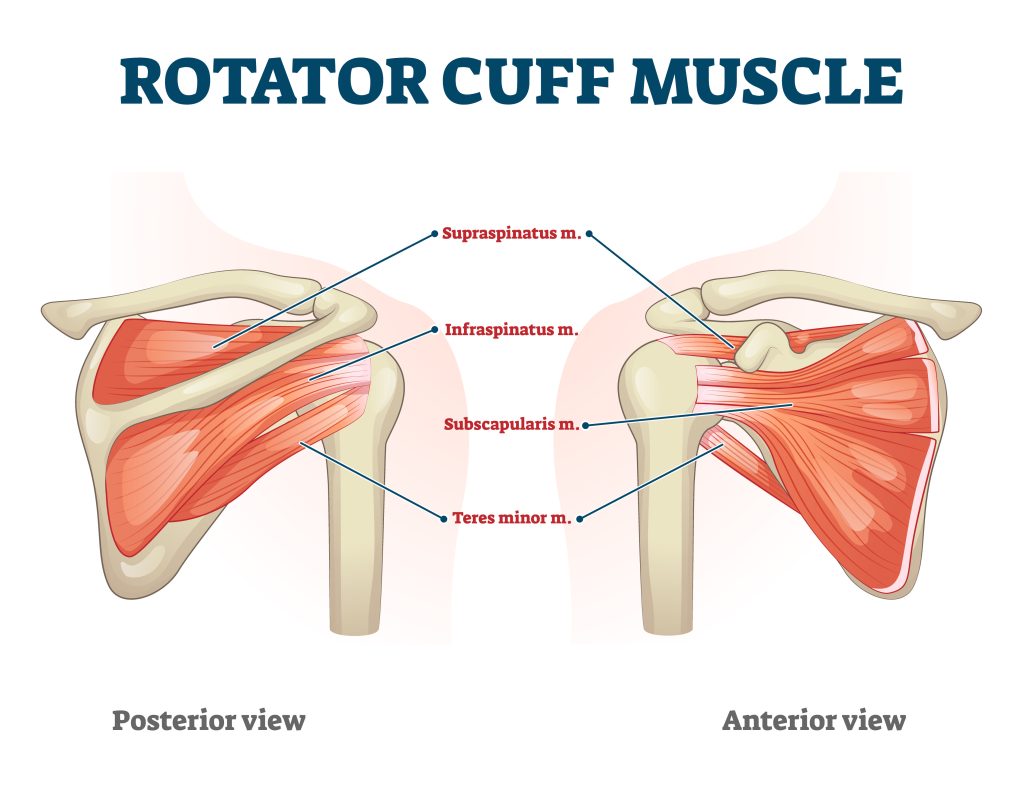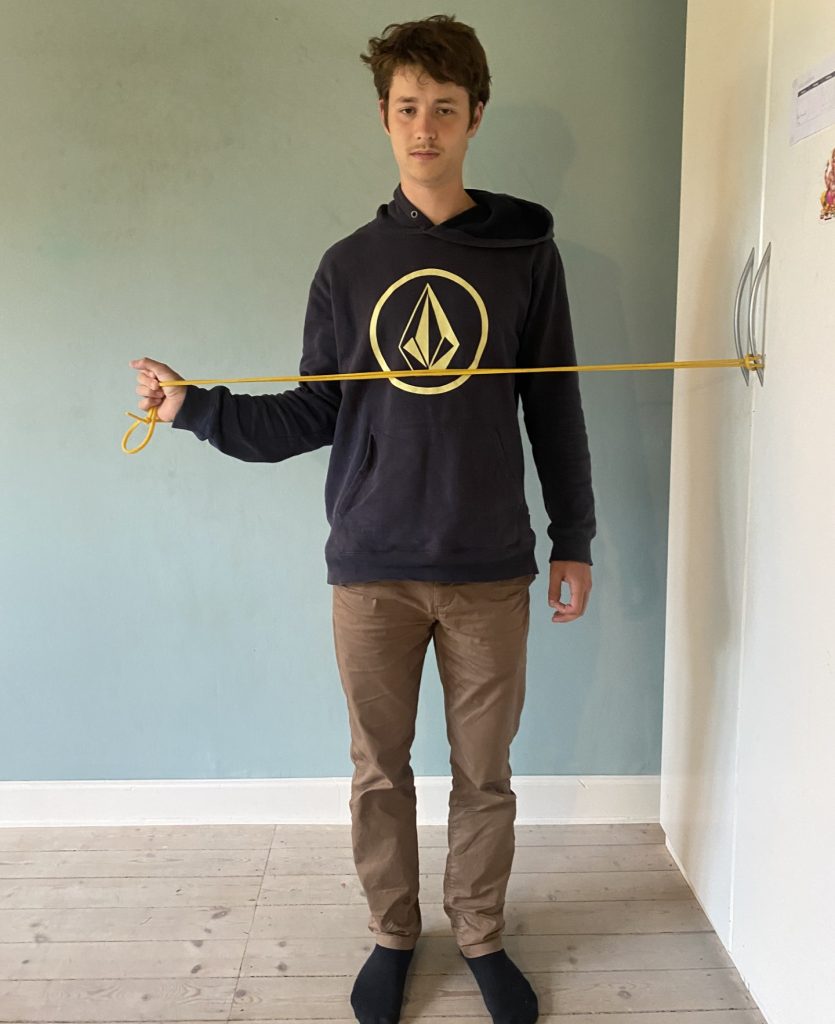If you train calisthenics training the rotator cuff muscles is a must, because of the unique stresses and demands placed on the shoulders during bodyweight exercises. A strong and well-conditioned rotator cuff is fundamental for mastering more challenging skills and maintaining shoulder health as you progress.

Table of Contents
Anatomy of Rotator Cuff Muscles: How To Isolate and Target Specific Muscles
To train the Rotator Cuff muscles effectively it is important to have a good understanding of the anatomy and function of the rotator cuff muscles, this way you will better understand how to isolate the different muscles and train them effectively.
The rotator cuff is a group of four muscles and their tendons that form a critical part of the shoulder joint. These muscles work together to stabilize the shoulder, control its movements, and allow for various arm motions.
Due to its crucial role in shoulder stability and motion, the rotator cuff is susceptible to overuse injuries, strains, and tears, especially in individuals who participate in sports with a high demand on the shoulders (such as calisthenics).
The four muscles that make up the rotator cuff are:

- Supraspinatus: The supraspinatus muscle is located on the upper and posterior part of the shoulder blade (scapula). It runs under the acromion, a bony prominence of the scapula, and inserts into the top of the humerus (upper arm bone). The supraspinatus helps to initiate abduction (lifting the arm away from the body) of the shoulder joint and plays a significant role in the first 15-20 degrees of this movement.
- Infraspinatus: The infraspinatus muscle is situated on the posterior aspect of the scapula, below the spine of the scapula. It attaches to the back of the humerus. The primary function of the infraspinatus is to externally rotate the shoulder joint, turning the arm outward.
- Teres Minor: The teres minor muscle is located just below the infraspinatus on the lateral side of the scapula. It also inserts into the back of the humerus and works alongside the infraspinatus to externally rotate the shoulder.
- Subscapularis: The subscapularis muscle is positioned on the anterior (front) side of the scapula and inserts into the front of the humerus. Unlike the other three rotator cuff muscles that externally rotate the shoulder, the subscapularis internally rotates the shoulder, turning the arm inward.
Top 5 Rotator Cuff Exercises
Now that you are familiar with the anatomy of the Rotator cuff muscles, it is time to pick some exercises that target the muscles of the rotator cuff. To help you train your rotator cuff muscles effectively, I’ve compiled a list of the best rotator cuff exercises you can do to stay injury free and develop strong and stable shoulders.
1. Ring face pulls
The first exercise on the list is of course the Face Pull, specifically face pulls done on the rings. The Ring Face Pulls is an effective exercise for strengthening the upper back muscles, including the posterior deltoids, rhomboids, and rotator cuff. Ring face pulls are excellent for maintaining structural balance and preventing injury because they indirectly engage the rotator cuff muscles, particularly the external rotators (Infraspinatus and Teres Minor).

How to perform the Ring Face Pull:
- Walk back to create tension in the rings and lean your body back while keeping your arms extended. Your body should form an angle, and your weight should be on your heels.
- Pull the rings towards your face by squeezing your shoulder blades together, keeping your elbows high and wide. Keep your wrists in a neutral position throughout the movement.
- At the top of the movement, squeeze your shoulder blades together and hold for a brief moment to maximize muscle activation.
- Slowly extend your arms back to the starting position, maintaining control throughout the entire range of motion.
Adjust the difficulty of the exercise by changing your body angle. The more upright your body, the easier the exercise becomes; the more horizontal your body, the more challenging it becomes.
2. Ring Reverse Fly
The Ring Reverse Fly is a highly effective exercise for engaging the upper back, shoulders, and rotator cuff muscles. By performing this exercise, you can strengthen the muscles responsible for external rotation of the shoulders and retracting the scapula. These muscles contribute significantly to shoulder stability and the overall integrity of the shoulder joint.

How to perform the Ring Reverse Fly:
- Hold one ring in each hand, palms facing each other, and step back to create tension in the rings. Your body should be in a slight backward lean with your arms extended straight out in front of you.
- Keeping your arms straight, slowly raise your arms out to the sides in a wide arc and slightly externally rotate the arms to put extra emphasis on the rotator cuff muscles.
- At the top of the movement, your arms should be in line with your body, forming a “T” position. Your shoulder blades should be squeezed together, and you should feel a contraction in the muscles of your upper back.
- Slowly return to the starting position by reversing the motion, bringing your arms back to the front of your body.
For the best results, use proper form and control during the movement. It’s difficult to perform Ring Rear Delt Flys with good form, so don’t be discouraged if you’re nearly vertical at first.
3. Pike Push Up
The Pike Push-Up is a great bodyweight exercise that targets the shoulders, including the rotator cuff muscles specifically the supraspinatus and infraspinatus. This exercise provides an effective way to strengthen the muscles that stabilize and support the shoulder joint.

How To Push Up like a pike:
- Start in a push-up position with your hands slightly wider than shoulder-width apart and your feet hip-width apart.
- Step backward with your feet, keeping your legs straight, until your body forms an inverted V shape. Your hips should be raised, and your body should resemble the letter “V” upside down.
- Ensure that your head is positioned between your arms, looking towards your feet.
- Bend your elbows and lower your head slowly to the ground, aiming to bring the top of your head to the floor. Maintain control while descending slowly.
- Pause briefly at the bottom position, ensuring stability and proper form.
- Extend your arms and push your body back up to the starting position by pushing through your palms.
Pro tips for perfect pike push ups:
- You should move slightly diagonally while performing the pike push up, creating a triangle with your head and hands at the bottom, not straight up and down! This is the most common mistake people make when performing the pike push up!
- Maintaining your weight on your toes is the best way to perform Pike Push Ups.
Use Resistance Bands and Weights
Using bands and weights can be great for isolating the rotator cuff muscles. This targeted engagement helps ensure that the rotator cuff muscles are working efficiently without being overpowered by stronger surrounding muscles.
4. External Rotations with Bands
External rotations with bands are an excellent exercise for targeting the external rotators of the shoulder, particularly the infraspinatus and teres minor muscles. This exercise is highly effective for strengthening and stabilizing the rotator cuff, promoting better shoulder mechanics and reducing the risk of shoulder injuries.

How to perform External Rotations with Bands:
- Begin by attaching the resistance band to a stationary object at waist height. You can use a doorknob, a pole, or any sturdy anchor point. Stand sideways to the anchor point with your feet shoulder-width apart.
- Hold the band with the hand the furthest away from the anchor point. Your elbow should be bent at a 90-degree angle.
- Initiate the movement by externally rotating your shoulder (rotating your forearm away from your body) against the resistance of the band. Keep your upper arm steady against your side, and use your shoulder muscles to control the movement.
- At the end of the movement, your forearms should be pointing away from your body, and your hands should be at the furthest point from your abdomen.
- Slowly return to the starting position by reversing the rotation, bringing your forearms back in front of your body.
Pro tips:
- Keep your core engaged and maintain proper posture throughout the exercise.
- Avoid shrugging your shoulders or using momentum to perform the movement. Focus on using the targeted muscles to control the rotation.
5. Lu raises
As popularised by Chinese Olympic weightlifting champion Lu Xiaojun, the Lu Raise is a variation of the normal lateral raise, which involves a wide range of motion, raising your arms all the way up until they meet overhead. The Lu Raise is an excellent exercise for strengthening the muscles around the shoulders and indirectly targeting the rotator cuff muscles.

How to perform raises like Lu Xiaojun:
- Stand tall with your feet shoulder-width apart and hold a dumbbell in each hand.
- Start with your arms in front of you, the two dumbells touching each other.
- Raise your arms out to the side and all the way overhead in a circular motion.
- Pause briefly at the top of the movement, when the dumbells meet each other overhead.
- Slowly lower the weights back to the starting position.
Final Thoughts
Training the rotator cuff is essential for anyone involved in calisthenics or bodyweight training. Calisthenics places unique demands on the shoulders, and having a strong and stable rotator cuff is crucial for performing advanced movements, preventing injuries, and maintaining overall shoulder health. If you have any existing shoulder issues, consider consulting a qualified professional or physical therapist.
To effectively train your rotator cuff for calisthenics, consider incorporating a variety of exercises that target different aspects of shoulder stability and strength. This may include resistance band exercises, bodyweight movements, and weights. Prioritize proper form and gradual progression, and use lighter weights for higher rep ranges (12-20 reps). This prevents the prime movers, the shoulders, from taking over the movement.
Overall, training the rotator cuff for calisthenics is an integral part of developing a strong, stable, and healthy shoulder complex. By giving attention to this important muscle group, you can enjoy a safer, more rewarding, and injury-free calisthenics journey.
Related posts:
Free Calisthenics Programs💪
Anton has been training calisthenics for many years and has experience coaching calisthenics. As a calisthenics nerd, I enjoy diving deep into various topics related to calisthenics.


